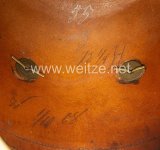Sandmann
Well-known member
Hello all,
I recently saw an officer's helmet at Weitze with an emblem that was attached to the helmet with split prongs. I then looked online and found various Saxon officer emblems that used similar attachments. All of these stars look authentic to me and all of them are highly domed Saxon stars.
Could it be an attachment method used by some Saxon makers, which came up with these highly domed stars? What do you think about originality?
I recently saw an officer's helmet at Weitze with an emblem that was attached to the helmet with split prongs. I then looked online and found various Saxon officer emblems that used similar attachments. All of these stars look authentic to me and all of them are highly domed Saxon stars.
Could it be an attachment method used by some Saxon makers, which came up with these highly domed stars? What do you think about originality?



